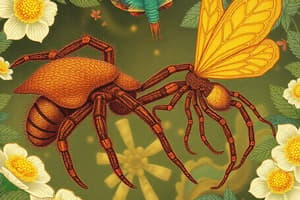Podcast
Questions and Answers
What is the primary mode of transmission (MOT) for Balantidiasis?
What is the primary mode of transmission (MOT) for Balantidiasis?
- Direct contact with infected individuals
- Vector-borne transmission via insects
- Consumption of fecally contaminated food or water (correct)
- Blood transfusions from infected donors
Which of the following symptoms is NOT typically associated with Trichomoniasis in women?
Which of the following symptoms is NOT typically associated with Trichomoniasis in women?
- Vaginal discharge
- Vaginitis
- Malodorous discharge
- Fever and chills (correct)
What type of organism is responsible for Malaria?
What type of organism is responsible for Malaria?
- Helminth
- Fungus
- Sporozoan (correct)
- Bacterium
Which of the following is associated with the symptoms of Malaria?
Which of the following is associated with the symptoms of Malaria?
What is the recommended patient care precaution for infections such as Balantidiasis or Trichomoniasis?
What is the recommended patient care precaution for infections such as Balantidiasis or Trichomoniasis?
Which species of Plasmodium is considered the most deadly?
Which species of Plasmodium is considered the most deadly?
What might be a serious outcome of untreated Malaria?
What might be a serious outcome of untreated Malaria?
How is Trichomoniasis predominantly transmitted?
How is Trichomoniasis predominantly transmitted?
Which of the following is a symptom of Balantidiasis?
Which of the following is a symptom of Balantidiasis?
What is a common route of infection for Malaria aside from mosquito bites?
What is a common route of infection for Malaria aside from mosquito bites?
Flashcards are hidden until you start studying
Study Notes
Parasitism Overview
- Parasitism is a symbiotic relationship where one organism benefits at the expense of another (the host).
- Parasites gain advantages by living on or in other living organisms.
Types of Parasites
-
Ectoparasites:
- Reside outside the host's body.
- Examples include mites, ticks, and lice.
-
Endoparasites:
- Live inside the host’s body.
- Examples include parasitic protozoa and helminths.
-
Facultative Parasite:
- Can exist independently or as a parasite.
-
Obligate Parasite:
- Must live as a parasite to survive.
- Most human-infecting parasites are obligate.
Parasitic Protozoa Classification
- Classified by locomotion:
- Amebas (Amoeba): Use pseudopodia (false feet) for movement.
- Flagellates: Move with whiplike flagella.
- Ciliates: Move using hairlike cilia.
- Sporozoa: Non-motile; do not exhibit movement.
Leishmaniasis
-
Caused by the genus Leishmania, a flagellated protozoa.
-
Transmission:
- Bites from infected female sandflies.
- Blood transfusions and person-to-person contact.
-
Forms of Leishmaniasis:
- Cutaneous: Papule enlarges into crater-like ulcers.
- Mucocutaneous: Severe tissue destruction and disfigurement from individual ulcers.
- Visceral (Kala-azar): Presents with fever, enlarged liver/spleen, anemia, and may result in death if untreated.
Acanthamoeba Infections
-
Transmission:
- Through soft contact lenses and nonsterile solutions.
- Contaminated spas or hot tubs.
-
Causes conjunctivitis and keratoconjunctivitis, leading to corneal inflammation.
Toxoplasmosis
-
Caused by Toxoplasma gondii, a sporozoan.
-
Transmission:
- Ingesting undercooked meat containing cysts.
- Contact with feces from infected cats or transplacentally.
-
Symptoms may be mild or resemble infectious mononucleosis, with severe outcomes in immunocompromised individuals.
Amebiasis
-
Infection by Entamoeba histolytica.
-
Transmission:
- Fecally contaminated food/water, usually via flies or food handlers.
-
Symptoms may vary in severity, often resulting in dysentery, fever, and diarrhea.
Balantidiasis
-
Caused by Balantidium coli, a ciliated protozoan.
-
Transmission:
- Ingesting pig feces contaminated food or water.
-
Can cause diarrhea, dysentery, colic, nausea, and vomiting.
Trichomoniasis
-
Caused by Trichomonas vaginalis, a flagellate.
-
Transmission:
- Direct sexual contact via infected vaginal and urethral discharges.
-
Typically causes vaginitis in women, manifesting as profuse, malodorous discharge.
Malaria
-
Caused by the genus Plasmodium (e.g., P. vivax, P. falciparum).
-
Transmission:
- Injection of sporozoites by Anopheles mosquitoes.
-
Symptoms include malaise, fever, chills, intermittent paroxysms, and can lead to severe complications such as renal failure and death if untreated.
Studying That Suits You
Use AI to generate personalized quizzes and flashcards to suit your learning preferences.



